Wet Relaxation of Electrospun Nanofiber Mats
Abstract
:1. Introduction
2. Materials and Methods
3. Results
4. Discussion
5. Conclusions
Author Contributions
Funding
Acknowledgments
Conflicts of Interest
References
- Greiner, A.; Wendorff, J.H. Electrospinning: A fascinating method for the preparation of ultrathin fibers. Angew. Chem. Int. Ed. 2007, 46, 5670–5703. [Google Scholar] [CrossRef] [PubMed]
- Salalha, W.; Dror, Y.; Khalfin, R.; Cohen, Y.; Yarin, A.L.; Zussman, E. Single-Walled Carbon Nanotubes Embedded in Oriented Polymeric Nanofibers by Electrospinning. Langmuir 2004, 20, 9852–9855. [Google Scholar] [CrossRef] [PubMed]
- Liu, H.H.; Li, Y.J.; Yuan, M.W.; Sun, G.B.; Liao, Q.L.; Zhang, Y. Solid and macroporous Fe3C/N-C nanofibers with enhanced electromagnetic wave absorbability. Sci. Rep. 2018, 8, 16832. [Google Scholar] [CrossRef] [PubMed]
- Döpke, C.; Grothe, T.; Steblinski, P.; Klöcker, M.; Sabantina, L.; Kosmalska, D.; Blachowicz, T.; Ehrmann, A. Magnetic Nanofiber Mats for Data Storage and Transfer. Nanomaterials 2019, 9, 92. [Google Scholar] [CrossRef] [PubMed]
- Pakravan, M.; Heuzey, M.-C.; Ajji, A. A fundamental study of chitosan/PEO electrospinning. Polymer 2011, 52, 4813–4824. [Google Scholar] [CrossRef]
- Wongchitphimon, S.; Wang, R.; Jiraratananon, R.; Shi, L.; Loh, C.H. Effect of polyethylene glycol (PEG) as an additive on the fabrication of polyvinylidene fluoride-co-hexafluropropylene (PVDF-HFP) asymmetric microporous hollow fiber membranes. J. Memb. Sci. 2011, 369, 329–338. [Google Scholar] [CrossRef]
- Grothe, T.; Wehlage, D.; Böhm, T.; Remche, A.; Ehrmann, A. Needleless electrospinning of PAN nanofibre mats. Tekstilec 2017, 60, 290–295. [Google Scholar] [CrossRef]
- Manoharan, M.P.; Sharma, A.; Desai, A.V.; Haque, M.A.; Bakis, C.E.; Wang, K.W. The interfacial strength of carbon nanofiber epoxy composite using single fiber pullout experiments. Nanotechnology 2009, 20, 5. [Google Scholar] [CrossRef]
- Ji, L.W.; Yao, Y.F.; Toprakci, O.; Lin, Z.; Liang, Y.Z.; Shi, Q.; Medfort, A.J.; Millns, C.R.; Zhang, X.W. Fabrication of carbon nanofiber-driven electrodes from electrospun polyacrylonitrile/polypyrrole bicomponents for high-performance rechargeable lithium-ion batteries. J. Power Sources 2010, 195, 2050–2056. [Google Scholar] [CrossRef]
- Jung, H.R.; Lee, W.J. Preparation and characterization of Ni-Sn/carbon nanofibers composite anode for lithium ion battery. J. Electrochem. Soc. 2011, 158, A644–A652. [Google Scholar] [CrossRef]
- Liu, J.W.; Essner, J.; Li, J. Hybrid supercapacitor based on coaxially coated manganese oxide on vertically aligned carbon nanofiber arrays. Chem. Mater. 2010, 22, 5022–5030. [Google Scholar] [CrossRef]
- Schnell, E.; Klinkhammer, K.; Balzer, S.; Brook, G.; Klee, D.; Dalton, P.; Mey, J. Guidance of glial cell migration and axonal growth on electrospun nanofibers of poly-epsilon-caprolactone and a collagen/polyepsilon-caprolactone blend. Biomaterials 2007, 28, 3012–3025. [Google Scholar] [CrossRef] [PubMed]
- Großerhode, C.; Wehlage, D.; Grothe, T.; Grimmelsmann, N.; Fuchs, S.; Hartmann, J.; Mazur, P.; Reschke, V.; Siemens, H.; Rattenholl, A.; et al. Investigation of microalgae growth on electrospun nanofiber mats. AIMS Bioeng. 2017, 4, 376–385. [Google Scholar] [CrossRef]
- Wang, L.; Zhang, C.; Gao, F.; Pan, G. Needleless electrospinning for scaled-up production of ultrafine chitosan hybrid nanofibers used for air filtration. RSC Adv. 2016, 6, 105988–105995. [Google Scholar] [CrossRef] [Green Version]
- Zhao, X.; Liu, Y.; Wang, C.; Liu, Q.S. Structure and filtration performance of fibrous composite membranes containing environmentally friendly materials for water purification. Fiber Polym. 2015, 16, 2586–2592. [Google Scholar] [CrossRef]
- Ferrero, F.; Periolatto, M.; Vineis, C.; Varesano, A. Chitosan coated cotton gauze for antibacterial water filtration. Carbohyd. Polym. 2014, 103, 207–212. [Google Scholar] [CrossRef] [PubMed]
- Roche, R.; Yalcinkaya, F. Incorporation of PVDF Nanofibre Multilayers into Functional Structure for Filtration Applications. Nanomaterials 2018, 8, 771. [Google Scholar] [CrossRef]
- Cooper, A.; Oldinski, R.; Ma, H.Y.; Bryers, J.D.; Zhang, M.Q. Chitosan-based nanofibrous membranes for antibacterial filter applications. Carbohyd. Polym. 2013, 92, 254–259. [Google Scholar] [CrossRef] [Green Version]
- Vasilyev, G.; Burman, M.; Arinstein, A. Estimating the Degree of Polymer Stretching during Electrospinning: An Experimental Imitation Method. Macromol. Mater. Eng. 2017, 302, 1600554. [Google Scholar] [CrossRef]
- Arinstein, A.; Zussman, E. Electrospun polymer nanofibers: Mechanical and thermodynamic perspectives. J. Polym. Sci. Part B Polym. Phys. 2011, 49, 691–707. [Google Scholar] [CrossRef] [Green Version]
- Ramachandramoorthy, R.; Beese, A.; Espinosa, H. In situ electron microscopy tensile testing of constrained carbon nanofibers. Int. J. Mech. Sci. 2018, 149, 452–458. [Google Scholar] [CrossRef]
- Munajat, N.A.; Nurfaizey, A.H.; Bahar, A.A.M.; You, K.Y.; Fadzullah, S.H.S.M.; Omar, G. High-frequency dielectric analysis of carbon nanofibers from PAN precursor at different pyrolysis temperatures. Microw. Opt. Technol. Lett. 2018, 60, 2198–2204. [Google Scholar] [CrossRef]
- Alarifi, I.M.; Khan, W.S.; Asmatulu, R. Synthesis of electrospun polyacrylonitrile-derived carbon fibers and comparison of properties with bulk form. PLoS ONE 2018, 13, e0201345. [Google Scholar] [CrossRef] [PubMed]
- Barua, B.; Saha, M.C. Studies of reaction mechanisms during stabilization of electrospun polyacrylonitrile carbon nanofibers. Polym. Eng. Sci. 2018, 58, 1315–1321. [Google Scholar] [CrossRef]
- Zhao, X.; Ma, X.F.; Zheng, P.W. The preparation of carboxylic-functional carbon-based nanofibers for the removal of cationic pollutants. Chemosphere 2018, 202, 298–305. [Google Scholar] [CrossRef] [PubMed]
- Ma, S.; Liu, J.; Liu, Q.; Liang, J.Y.; Zhao, Y.; Fong, H. Investigation of structural conversion and size effect from stretched bundle of electrospun polyacrylonitrile copolymer nanofibers during oxidative stabilization. Mater. Des. 2016, 95, 387–397. [Google Scholar] [CrossRef]
- Wu, S.; Zhang, F.; Yu, Y.H.; Li, P.; Yang, X.P.; Lu, J.G.; Rye, S.K. Preparation of PAN-based carbon nanofibers by hot-stretching. Compos. Interfaces 2008, 15, 671–677. [Google Scholar] [CrossRef]
- Xie, Z.; Niu, H.; Lin, T. Continuous polyacrylonitrile nanofiber yarns: Preparation and drydrawing treatment for carbon nanofiber production. RSC Adv. 2015, 5, 15147–15153. [Google Scholar] [CrossRef]
- Ma, S.; Liu, J.; Qu, M.; Wang, X.; Huang, R.; Liang, J. Effects of carbonization tension on the structural and tensile properties of continuous bundles of highly aligned electrospun carbon nanofibers. Mater. Lett. 2016, 183, 369–373. [Google Scholar] [CrossRef]
- Santos de Oliveira, M., Jr.; Manzolli Rodrigues, B.V.; Marcuzzo, J.S.; Guerrini, L.M.; Baldan, M.R.; Rezende, M.C. A statistical approach to evaluate the oxidative process of electrospun polyacrylonitrile ultrathin fibers. J. Appl. Polym. Sci. 2017, 134, 45458. [Google Scholar] [CrossRef]
- Wu, M.; Wang, Q.Y.; Li, K.; Wu, Y.Q.; Liu, H.Q. Optimization of stabilization conditions for electrospun polyacrylonitrile nanofibers. Polym. Degrad Stab. 2012, 97, 1511–1519. [Google Scholar] [CrossRef]
- Sabantina, L.; Klöcker, M.; Wortmann, M.; Rodrígues-Mirasol, J.; Cordero, T.; Moritzer, E.; Finsterbusch, K.; Ehrmann, A. Stabilization of PAN nanofiber mats obtained by needleless electrospinning using DMSO as solvent. J. Ind. Text. 2019. [Google Scholar] [CrossRef]
- Sabantina, L.; Wehlage, D.; Klöcker, M.; Mamun, A.; Grothe, T.; Rodrígues-Mirasol, J.; Cordero, T.; Finsterbusch, K.; Ehrmann, A. Stabilization of electrospun PAN/gelatin nanofiber mats for carbonization. J. Nanomater. 2018, 2018, 6131085. [Google Scholar] [CrossRef]
- Sabantina, L.; Rodríguez-Cano, M.A.; Klöcker, M.; García-Gateos, F.J.; Ternero-Hidalgo, J.J.; Mamun, A.; Beermann, F.; Schwakenberg, M.; Voigt, A.-L.; Rodríguez-Mirasol, J.; et al. Fixing PAN nanofiber mats during stabilization for carbonization and creating novel metal/carbon composites. Polymers 2018, 10, 735. [Google Scholar] [CrossRef]
- Quaynor, L.; Nakajima, M.; Takahashi, M. Dimensional changes in knitted silk and cotton fabrics with laundering. Text. Res. J. 1999, 69, 285–291. [Google Scholar] [CrossRef]
- Quaynor, L.; Takahashi, M.; Nakajima, M. Effects of laundering on bending properties of plain-knitted fabrics. J. Text. Mach. Soc. Jpn. (Engl. Ed.) 1998, 44, 74–77. [Google Scholar] [CrossRef]
- Chen, Q.H.; Au, K.F.; Yuen, C.W.M.; Yeung, K.W. Dimensional stability of plain wool knits. Text. Asia 2000, 31, 51–57. [Google Scholar]
- Knapton, J.J.F.; Ahrens, F.J.; Ingenthron, W.W.; Fong, W. The dimensional properties of knitted wool fabrics, Part I: The plain-knitted structure. Text. Res. J. 1968, 10, 999–1012. [Google Scholar] [CrossRef]
- Ehrmann née Tillmanns, A.; Heimlich, F.; Brücken, A.; Weber, M.O.; Blachowicz, T. Experimental investigation of the washing relaxation of knitted fabrics from polyester yarn with stainless steel fibres. Fibres Text. East. Eur. 2012, 20, 90–93. [Google Scholar]
- Bahl, O.P.; Shen, Z.M.; Lavin, J.G.; Ross, R.A. Manufacture of Carbon Fibers. In Carbon Fibers, 3rd ed.; Donnet, J.-B., Wang, T.K., Peng, J.C.M., Rebouillat, S., Eds.; CRC Press, Taylor & Francis Group: Boca Raton, FL, USA; London, UK; New York, NY, USA, 1998. [Google Scholar]
- Sabantina, L.; Hes, L.; Rodríguez-Mirasol, C.T.; Ehrmann, A. Water vapor permeability through PAN nanofiber mat with varying membrane-like areas. Fibres Text. East. Eur. 2019, 133, 12–15. [Google Scholar] [CrossRef]
- Döpke, C.; Juhász Junger, I.; Steblinski, P.; Ehrmann, A.; Blachowicz, T. Electrospinning Magnetic Nanofibers for Neuromorphic Computing. Int. Fiber J. 2018, 2018, 37–39. [Google Scholar]
- Gsell, E.; Heimlich, F.; Ehrmann, A.; Weber, M.O. Dependence of dry, wet and washing relaxation on knitted structures and fabric parameters. Ind. Text. 2017, 68, 121–125. [Google Scholar]
- Deitzel, J.M.; Kleinmeyer, J.; Harris, D.; Beck Tan, N.C. The effect of processing variables on the morphology of electrospun nanofibers and textiles. Polymer 2001, 42, 261–272. [Google Scholar] [CrossRef]
- Li, D.; Wang, Y.L.; Xia, Y.N. Electrospinning of Polymeric and Ceramic Nanofibers as Uniaxially Aligned Arrays. Nano Lett. 2003, 3, 1167–1171. [Google Scholar] [CrossRef]
- Lee, J.H.; Boo, C.H.; Ryu, W.H.; Taylor, A.D.; Elimelech, M. Development of Omniphobic Desalination Membranes Using a Charged Electrospun Nanofiber Scaffold. ACS Appl. Mater. Interfaces 2016, 8, 11154–11161. [Google Scholar] [CrossRef] [PubMed]
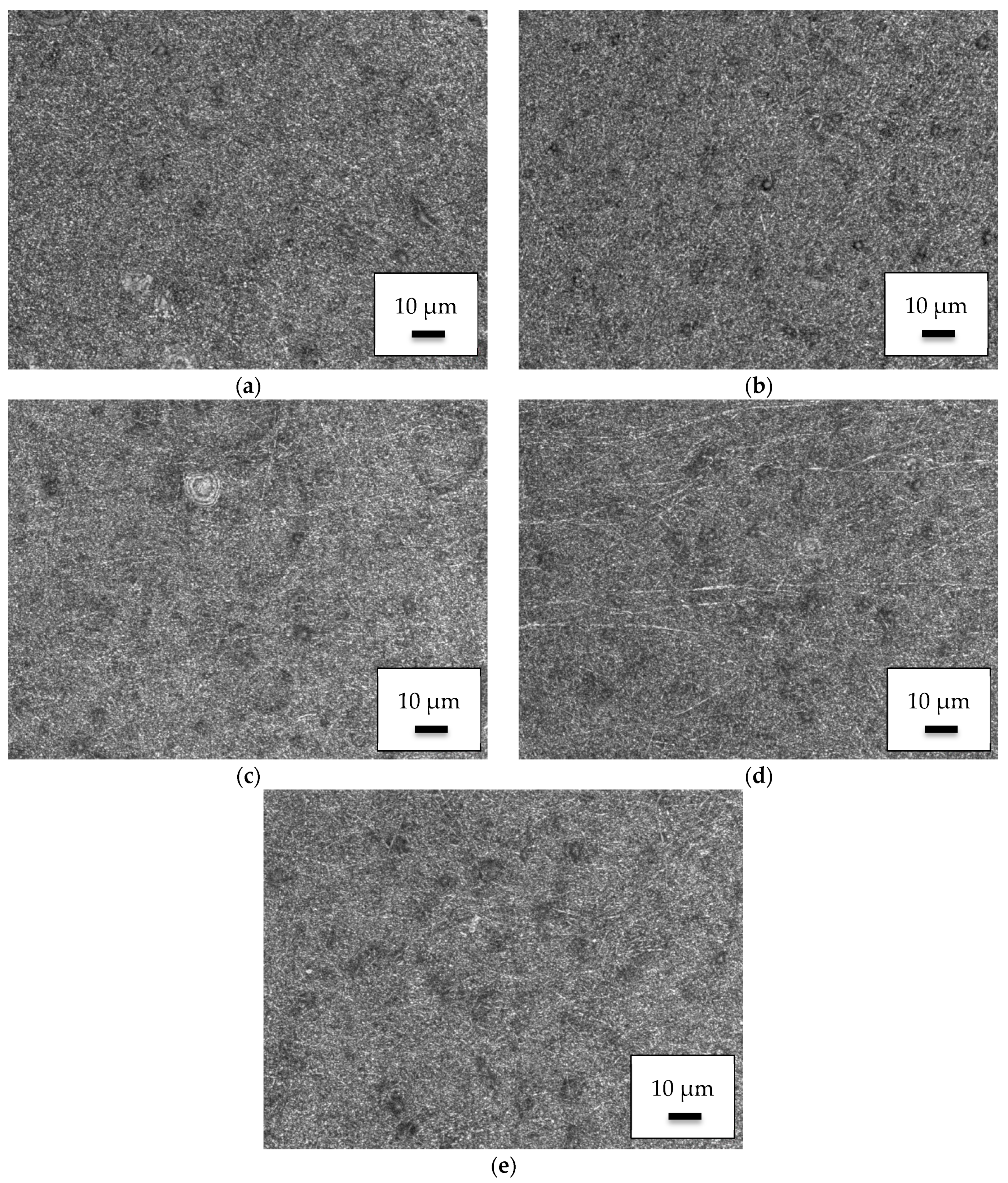
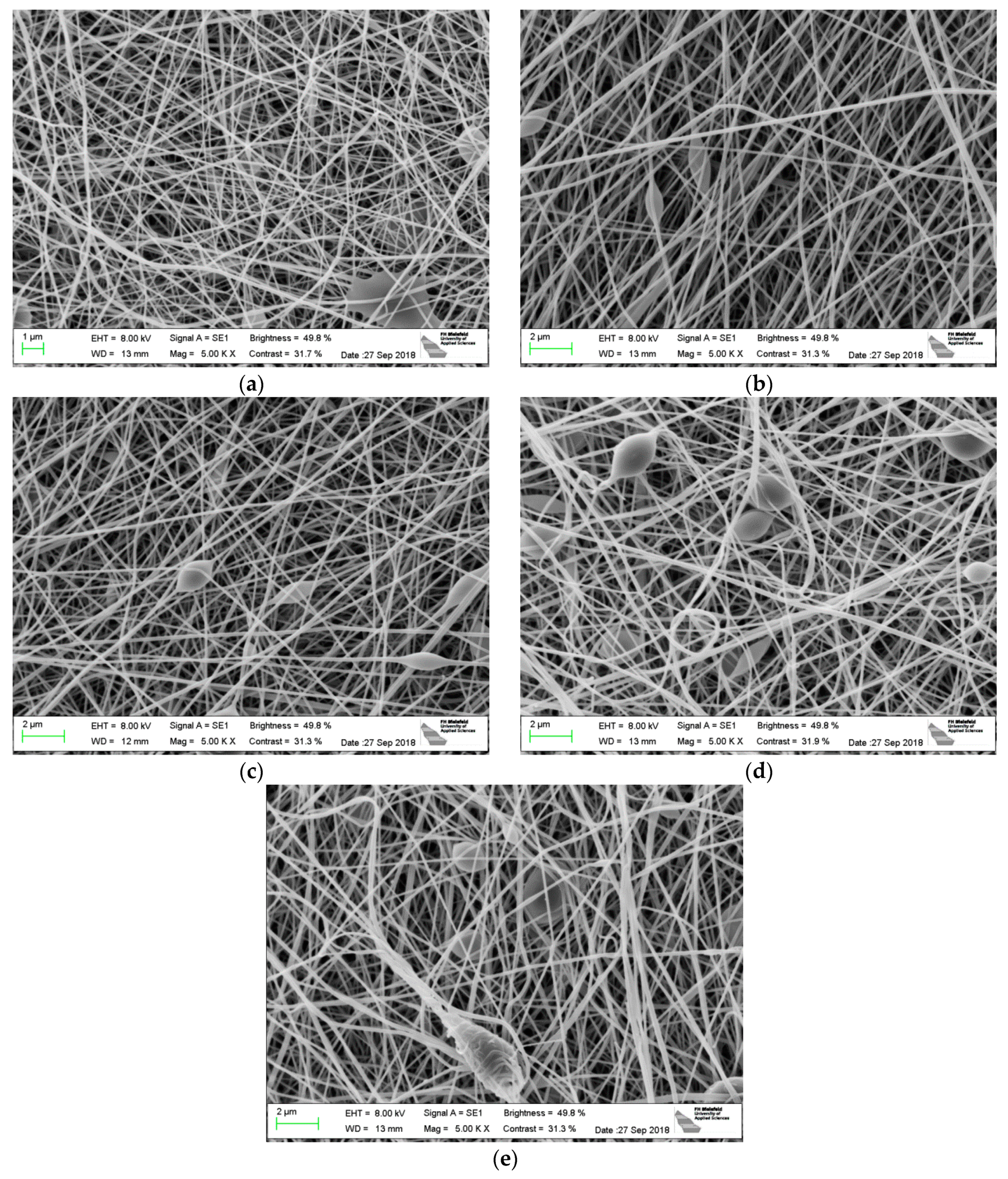
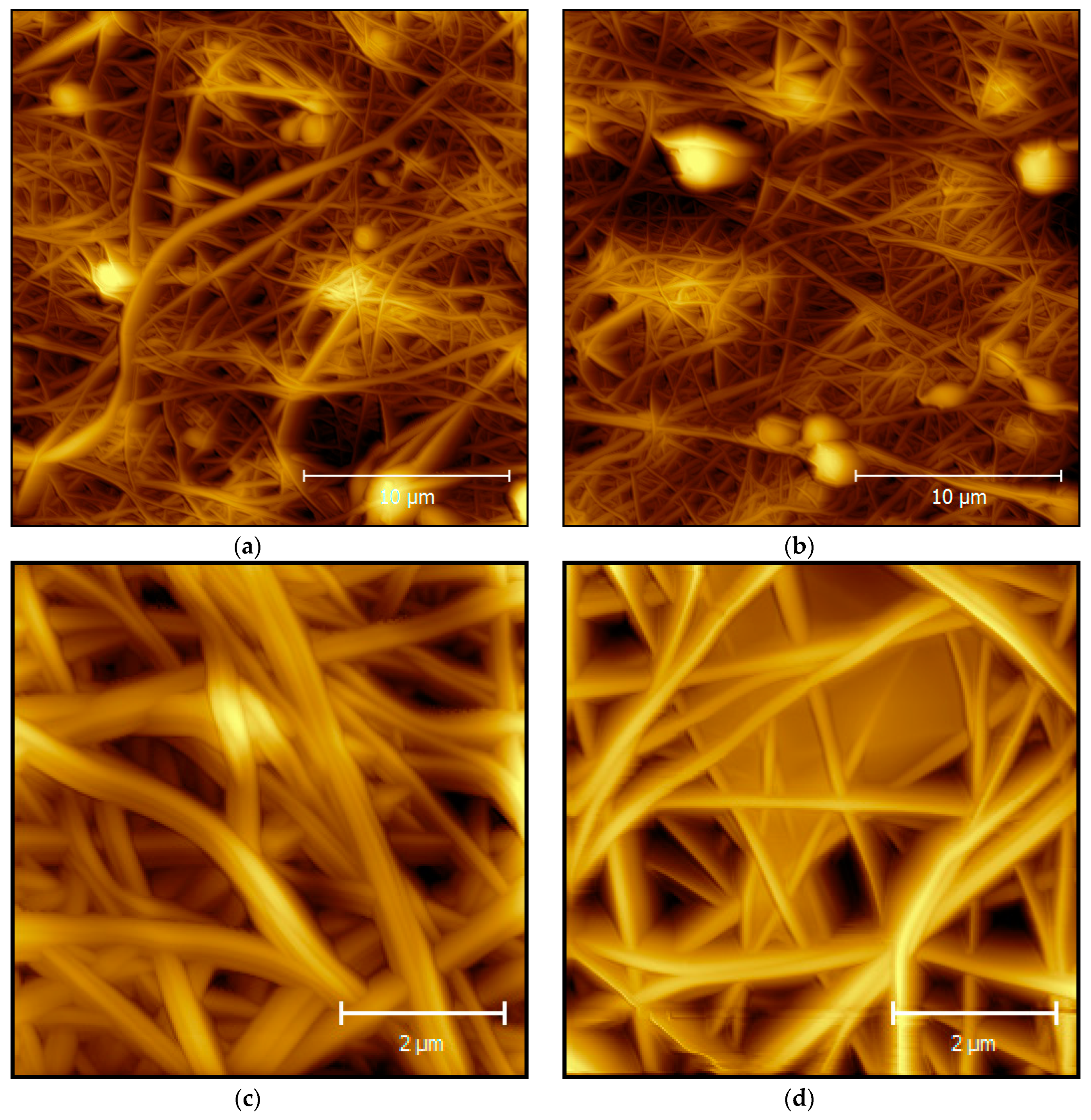

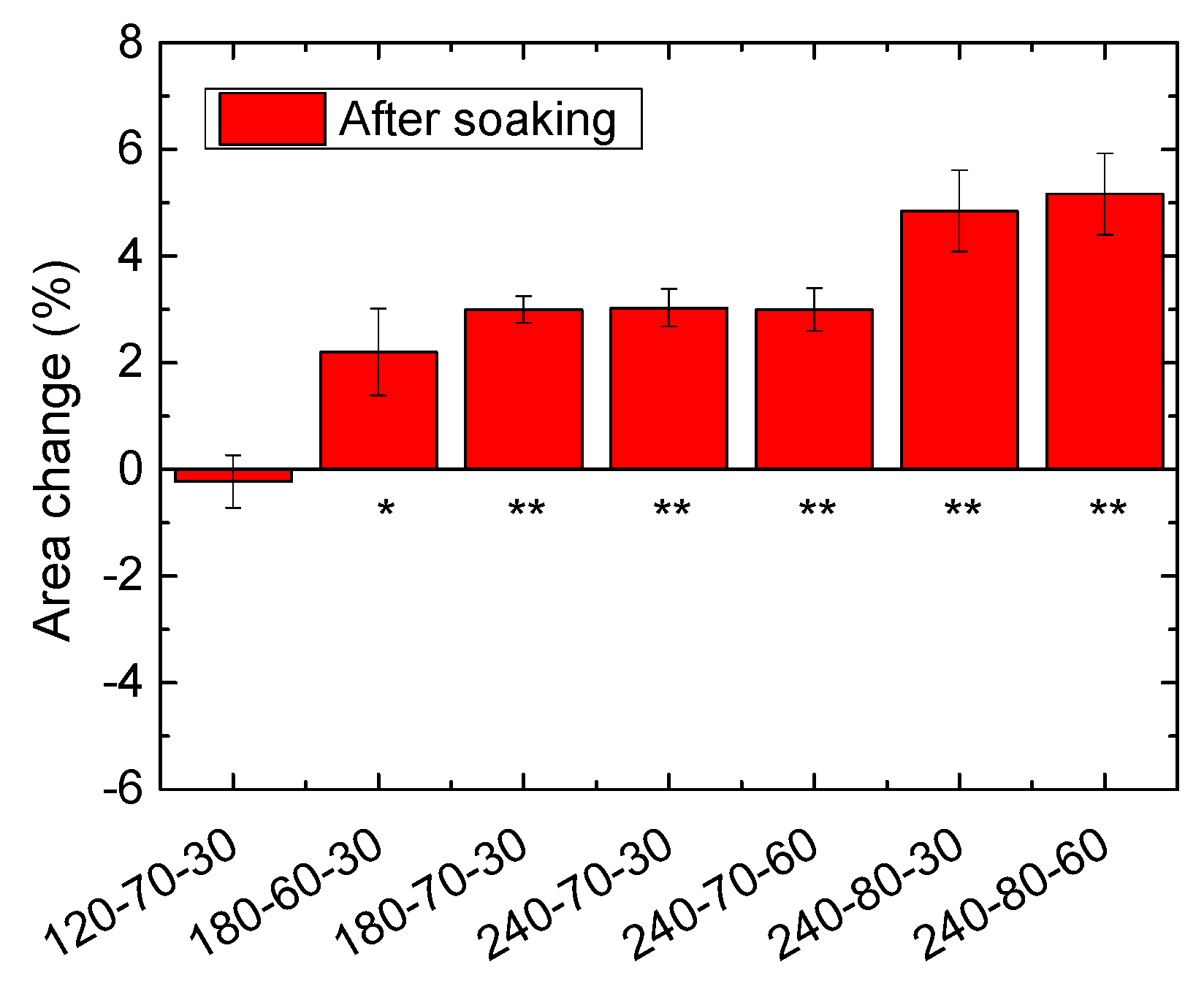
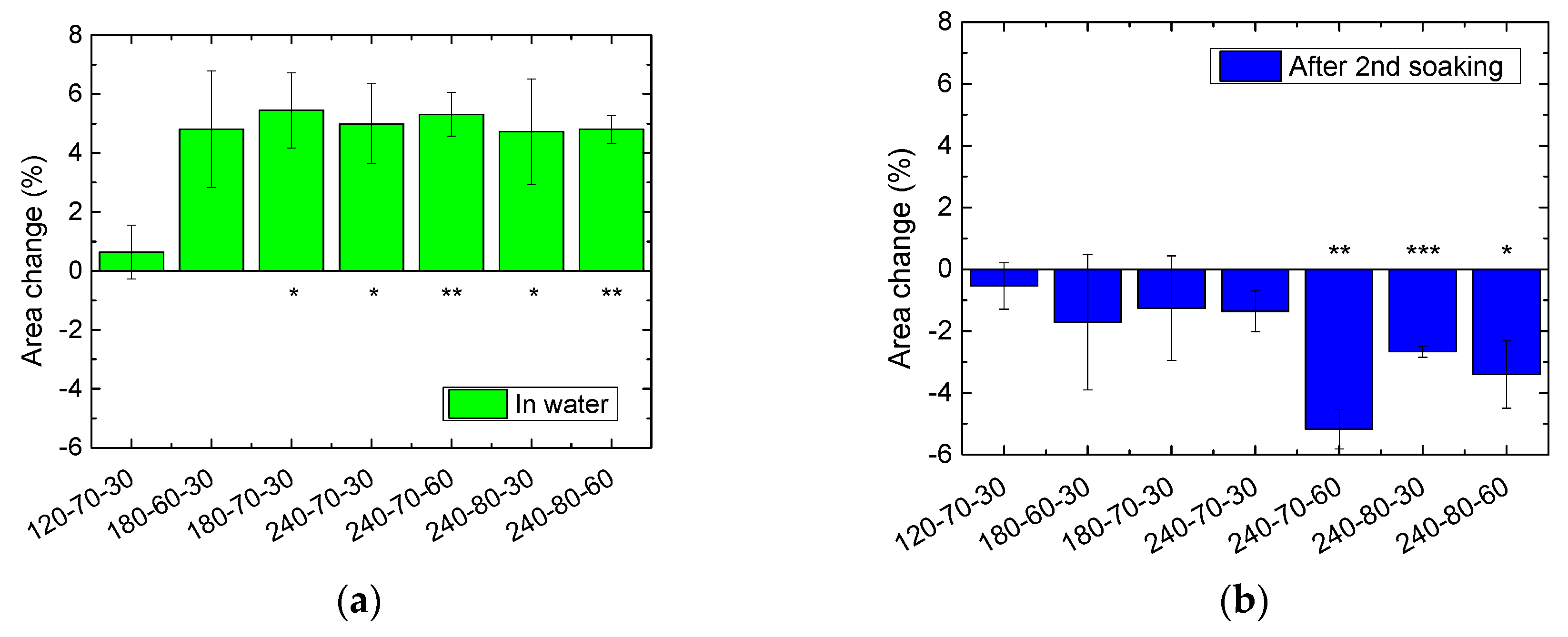
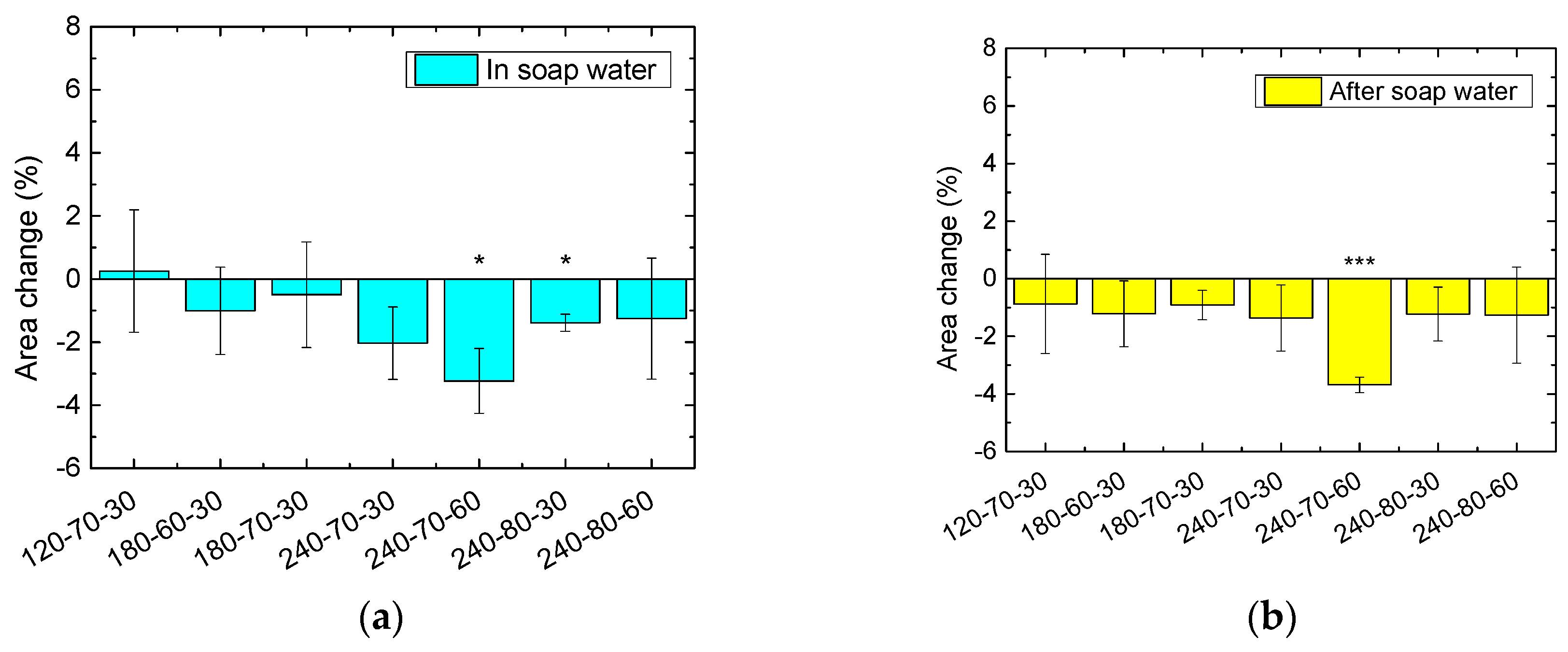
| Sample Codes | E/S Distance (mm) | Voltage (kV) | Spinning Duration (min) | Areal Weight (g/m²) |
|---|---|---|---|---|
| 120-70-30 | 120 | 70 | 30 | 28 ± 4 |
| 180-60-30 | 180 | 60 | 30 | 9.5 ± 0.7 |
| 180-70-30 | 180 | 70 | 30 | 11.3 ± 1.0 |
| 240-70-30 | 240 | 70 | 30 | 4.1 ± 0.3 |
| 240-70-60 | 240 | 70 | 60 | 8.6 ± 0.5 |
| 240-80-30 | 240 | 80 | 30 | 3.2 ± 0.3 |
| 240-80-60 | 240 | 80 | 60 | 6.2 ± 0.9 |
| Parameter | Value |
|---|---|
| Current (mA) | 0.06–0.09 |
| Nozzle diameter (mm) | 0.9 |
| Carriage speed (mm/s) | 100 |
| Substrate speed (mm/min) | 0 |
| Ground-substrate distance (mm) | 50 |
| Temperature in chamber (°C) | 21–23 |
| Relative humidity in chamber (%) | 31–33 |
© 2019 by the authors. Licensee MDPI, Basel, Switzerland. This article is an open access article distributed under the terms and conditions of the Creative Commons Attribution (CC BY) license (http://creativecommons.org/licenses/by/4.0/).
Share and Cite
Grothe, T.; Sabantina, L.; Klöcker, M.; Junger, I.J.; Döpke, C.; Ehrmann, A. Wet Relaxation of Electrospun Nanofiber Mats. Technologies 2019, 7, 23. https://doi.org/10.3390/technologies7010023
Grothe T, Sabantina L, Klöcker M, Junger IJ, Döpke C, Ehrmann A. Wet Relaxation of Electrospun Nanofiber Mats. Technologies. 2019; 7(1):23. https://doi.org/10.3390/technologies7010023
Chicago/Turabian StyleGrothe, Timo, Lilia Sabantina, Michaela Klöcker, Irén Juhász Junger, Christoph Döpke, and Andrea Ehrmann. 2019. "Wet Relaxation of Electrospun Nanofiber Mats" Technologies 7, no. 1: 23. https://doi.org/10.3390/technologies7010023
APA StyleGrothe, T., Sabantina, L., Klöcker, M., Junger, I. J., Döpke, C., & Ehrmann, A. (2019). Wet Relaxation of Electrospun Nanofiber Mats. Technologies, 7(1), 23. https://doi.org/10.3390/technologies7010023







